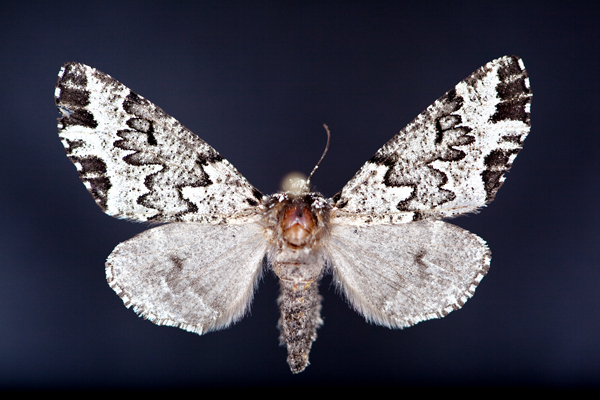L'arna d'aquest dilluns és una espècie espectacular de les muntanyes d'Arizona – Chiricahua multidentata, una geometria. L'únic lloc conegut per a aquesta espècie és al cim de les muntanyes Chiricahua 9,000 peus (que s'acabava de donar a un cruixent). Tant de bo el foc no hagi estat del tot devastador i la població es recuperi en els propers anys. Abans 2009 aquesta arna es coneixia des de menys de 10 espècimens, tots capturats a l'elevació una mica més baixa a Onion Saddle a les Chiricahuas. A la primavera de 2009 l'accés a una carretera tancada condueix a la recollida de desenes d'exemplars en una sola nit. Tots els registres anteriors havien estat rars que havien baixat a 8500′ – sinó el simple fet de fer pujar un extra 1000′ 500'posava el col·lector a l'hàbitat ideal i, sorprenentment, aquesta arna era comuna! Això sembla ser igual al curs amb la majoria d'insectes, molt pocs són realment rars, mentre que la resta són difícils de capturar. O no surten a la llum, no busquis dins del braç, o només viuen en hàbitats de difícil accés. Un cop descobriu la seva biologia (o tenir sort) normalment pots trobar l'animal en abundància.
És possible que també hagis notat la publicació habitual de Monday Moth – He estat al camp durant les últimes dues setmanes i tenia un munt de publicacions programades. Ara hauria de començar a barrejar més coses!


Així, now you’ve got me wondering what this species depends upon (vegetation: food for self & progeny, shelter) and how that responds to fire…
Sí, indeed, re: things that live near roads and trails SEEM v. common vs. things that avoid same. Reminds me of a story of an older gentleman who lived I think in Owens Valley?? My moth friend said this guy had seen a particular moth only when it was below 32 dF (forgive me if I’m repeating myself), penso 27 or so, and no body believed him. Then the guys went out to try and find it. 32 F, cap arna. 30 F, cap arna, 27 F, this moth starts flying around. Do you know this story and/or the moth?
=) De totes maneres, thanks for the post of the lofty moth.
I’m not sure I’ve heard the exact story you’re recalling – but I know of lots of examples like this. I just collected a series of Gazoryctra wielgusi in Arizona and they only fly for 15 minutes between 7:45 i 8 (later in August they fly a little earlier, but still for 15 minuts). I actually set my alarm on my phone and the first moth flew in at 7:47 and the last one at 7:58. Amazing!
En realitat, even more subtle than this. The elevation difference is closer to 500 peus, and the vegetation looks very much the same at the higher location than down at Rustler Park/Onion Saddle
Thanks for the clarification!
Guau, super interesting (745 – 8).
Do you know the plant species your Monday Moth depends upon?
Officially the host plant is unknown – but one female did lay eggs on a pine stem when offered a large choice of local plants. The egg’s didn’t hatch, but it’s not too unreasonable to guess pine is preferred.